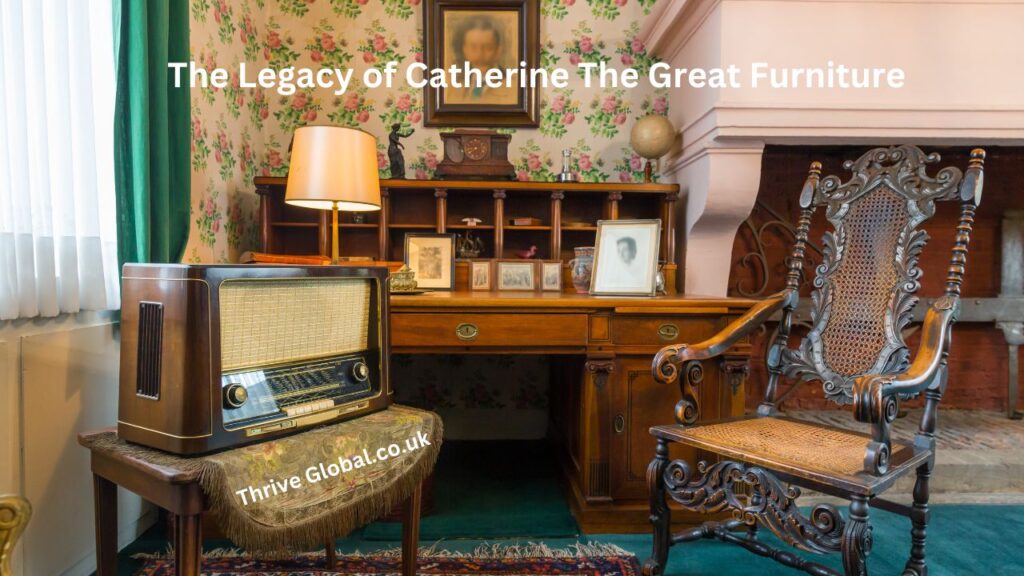Catherine the Great is a name synonymous with grandeur and sophistication. Her reign was marked not just by political prowess but by a profound influence on art and culture. Among her many legacies, Catherine the Great’s furniture stands out as a testament to her taste and vision, blending Russian opulence with European elegance.
Catherine the Great: A Brief Biography
Catherine the Great, born Sophie Friederike Auguste von Anhalt-Zerbst, ascended to the Russian throne in 1762. Her rule, extending until 1796, was marked by significant political and cultural reforms. She transformed Russia into one of the great powers of Europe, not only through military and administrative achievements but also by fostering an environment where the arts could flourish.
The Influence of Catherine the Great on Art and Culture
Catherine was an ardent patron of the arts. She amassed a vast collection of paintings, sculptures, and decorative arts, and her efforts helped to westernize Russian culture. Her reign saw the construction of grand palaces and the commissioning of elaborate furniture pieces, blending the best of European styles with Russian craftsmanship.
The Birth of Catherine the Great Furniture
The furniture from Catherine the Great’s era is a unique blend of various European influences, primarily Neoclassicism and Rococo, with a distinctive Russian twist. These pieces were not just functional items but works of art, reflecting the wealth and power of the Russian Empire under her rule.
Design Elements of Catherine the Great Furniture
Catherine the Great’s furniture is renowned for its luxurious materials, including fine woods, gilded accents, and sumptuous fabrics. The craftsmanship is impeccable, often involving intricate marquetry, carving, and gilding. Each piece was designed to reflect both beauty and status, with many featuring elaborate motifs and symbols of power.
Styles and Themes
Neoclassicism
One of the predominant styles in Catherine the Great’s furniture is Neoclassicism. This style, inspired by the classical art and architecture of ancient Greece and Rome, emphasized symmetry, straight lines, and the use of classical motifs such as laurel wreaths and columns.
Rococo Influences
While Neoclassicism provided a structured foundation, Rococo brought a lighter, more decorative touch. Rococo elements in Catherine the Great’s furniture include ornate scrollwork, playful motifs, and an overall sense of whimsy and elegance.
Russian Baroque
Russian Baroque, with its boldness and grandeur, also influenced Catherine’s furniture designs. This style is characterized by its elaborate decorations, rich colors, and dynamic compositions, reflecting the opulence of the Russian court.
Also Read: Marc Gabelli Greenwich Perspectives on Global Markets
Famous Pieces and Their Histories
The Amber Room
One of the most famous examples of Catherine the Great’s taste in furniture and decor is the Amber Room. Originally constructed in the 18th century, this room was adorned with amber panels, gold leaf, and mirrors, creating a breathtakingly luxurious space.
Tsarskoye Selo
Tsarskoye Selo, Catherine’s summer residence, is another showcase of her influence on interior design. The palace features numerous rooms furnished with exquisite pieces that blend various European styles with Russian artistry.
The Winter Palace
The Winter Palace in St. Petersburg, a key residence for Russian monarchs, houses many pieces from Catherine’s time. The grandeur of the palace’s interiors, with their richly decorated rooms, stands as a testament to her impact on Russian decor.
The Craftsmen Behind the Masterpieces
Catherine the Great worked with some of the most skilled artisans of her time, both Russian and European. These craftsmen included renowned cabinetmakers, carvers, and gilders who helped bring her vision to life. Collaboration with European artists ensured that the furniture reflected the latest trends while maintaining a uniquely Russian character.
Catherine the Great’s Palaces: Showcases of Opulence
Overview of Significant Palaces
Catherine’s numerous palaces, including the Winter Palace, Tsarskoye Selo, and the Catherine Palace, were adorned with some of the most magnificent furniture pieces of her era. These palaces served not only as royal residences but also as showcases for her extensive art and furniture collections.
Interior Design and Furnishings
The interiors of these palaces were designed to impress, with grand halls, opulent dining rooms, and luxurious private chambers. The furniture played a crucial role in creating these awe-inspiring spaces, with each piece carefully selected or commissioned to enhance the overall aesthetic.
Impact on Subsequent Russian Design
The influence of Catherine the Great’s furniture extended well beyond her reign. Future generations of Russian designers drew inspiration from her taste and the pieces she commissioned. Her emphasis on combining functionality with beauty set a standard for Russian interior design that endured through the centuries.
Global Influence of Catherine the Great Furniture
Catherine the Great’s furniture gained international recognition and remains highly regarded in the world of antiques and art history. Today, her pieces can be found in museums and private collections around the globe, admired for their craftsmanship and historical significance.
Collecting Catherine the Great Furniture Today
Market Value and Rarity
Catherine the Great’s furniture is highly sought after by collectors. The rarity and historical importance of these pieces contribute to their significant market value. Auctions featuring her furniture often attract attention from collectors and institutions worldwide.
Tips for Collectors
For those interested in collecting Catherine the Great’s furniture, it’s essential to focus on provenance and authenticity. Working with reputable dealers and obtaining thorough documentation can help ensure that the pieces are genuine. Additionally, understanding the historical context and stylistic elements can aid in identifying authentic items.
Preservation and Restoration
Efforts to Maintain Historical Pieces
Preserving the legacy of Catherine the Great’s furniture involves meticulous care and restoration efforts. Institutions and private collectors alike invest in preserving these historical pieces, ensuring they remain in excellent condition for future generations to appreciate.
Challenges and Techniques in Restoration
Restoring Catherine the Great’s furniture poses unique challenges due to the intricate craftsmanship and delicate materials involved. Restoration experts employ advanced techniques to repair and conserve these pieces, maintaining their original beauty while ensuring structural integrity.
Catherine the Great Furniture in Popular Culture
Catherine the Great’s furniture has appeared in various films and literature, symbolizing opulence and power. These appearances help keep her legacy alive in popular culture, allowing new audiences to appreciate the historical and artistic significance of her furniture.
Conclusion
Catherine the Great’s legacy extends far beyond her political achievements; it is profoundly etched in the art and culture of Russia, particularly through her remarkable contributions to furniture design. Her pieces stand as a testament to a time when craftsmanship and artistry were paramount, blending various European styles with Russian grandeur. The enduring appeal of Catherine the Great’s furniture is a reflection of her unique vision and the timeless beauty she sought to create.
Also Read: Marc Joseph Gabelli Master of Finance Market Winning Strategies
FAQs
What makes the great’s furniture picture unique?
Catherine the Great’s furniture is unique due to its blend of Neoclassical, Rococo, and Russian Baroque styles, luxurious materials, and intricate craftsmanship.
How did furniture of the Catherin influence Russian art?
Catherine the Great influenced Russian art by promoting Western styles, commissioning numerous works, and supporting artists and craftsmen, leading to a cultural renaissance.
Where can I see catherine the great’s furniture picture today?
Catherine the Great’s furniture can be seen in various museums worldwide, including the Hermitage Museum in St. Petersburg and the Victoria and Albert Museum in London.
How valuable is Catherine the Great furniture?
Catherine the Great’s is highly valuable, often fetching significant sums at auctions due to its rarity, historical significance, and exquisite craftsmanship.
What are the main styles of the Great furniture of Catherine ?
The main styles of Catherine furniture include Neoclassicism, Rococo, and Russian Baroque, each contributing to the overall elegance and grandeur of her pieces.



